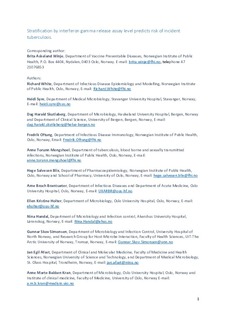Stratification by interferon-γ release assay level predicts risk of incident TB
Winje, Brita Askeland; White, Richard Aubrey; Syre, Heidi; Skutlaberg, Dag Harald; Oftung, Fredrik; Mengshoel, Anne Torunn; Blix, Hege Salvesen; Brantsæter, Arne Broch; Holter, Ellen; Handal, Nina; Simonsen, Gunnar Skov; Afset, Jan Egil; Kran, Anne-Marte Bakken
Journal article, Peer reviewed
Accepted version
Permanent lenke
http://hdl.handle.net/11250/2588271Utgivelsesdato
2018Metadata
Vis full innførselSamlinger
Sammendrag
Introduction Targeted testing and treatment of latent TB infection (LTBI) are priorities on the global health agenda, but LTBI management remains challenging. We aimed to evaluate the prognostic value of the QuantiFERON TB-Gold (QFT) test for incident TB, focusing on the interferon (IFN)-γ level, when applied in routine practice in a low TB incidence setting.
Methods In this large population-based prospective cohort, we linked QFT results in Norway (1 January 2009–30 June 2014) with national registry data (Norwegian Surveillance System for Infectious Diseases, Norwegian Prescription Database, Norwegian Patient Registry and Statistics Norway) to assess the prognostic value of QFT for incident TB. Participants were followed until 30 June 2016. We used restricted cubic splines to model non-linear relationships between IFN-γ levels and TB, and applied these findings to a competing risk model.
Results The prospective analyses included 50 389 QFT results from 44 875 individuals, of whom 257 developed TB. Overall, 22% (n=9878) of QFT results were positive. TB risk increased with the IFN-γ level until a plateau level, above which further increase was not associated with additional prognostic information. The HRs for TB were 8.8 (95% CI 4.7 to 16.5), 19.2 (95% CI 11.6 to 31.6) and 31.3 (95% CI 19.8 to 49.5) times higher with IFN-γ levels of 0.35 to <1.00, 1.00 to <4.00 and >4.00 IU/mL, respectively, compared with negative tests (<0.35 IU/mL).
Conclusions Consistently, QFT demonstrates increased risk of incident TB with rising IFN-γ concentrations, indicating that IFN-γ levels may be used to guide targeted treatment of LTBI.
